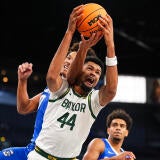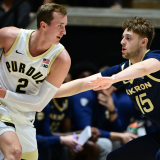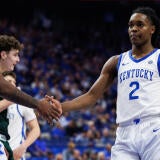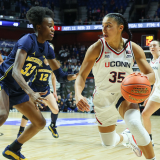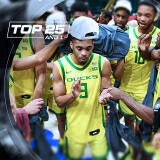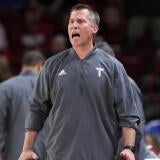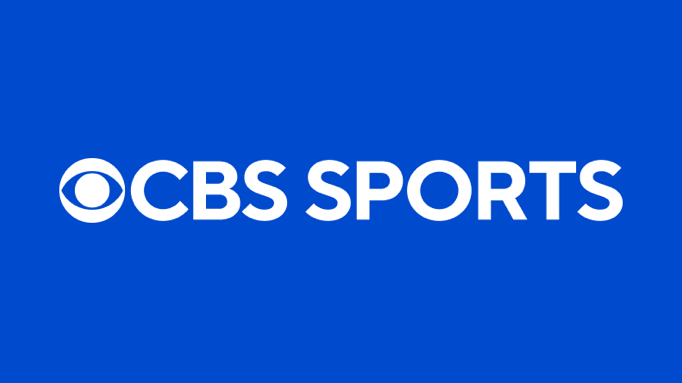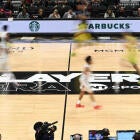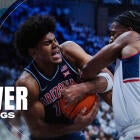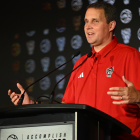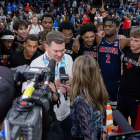College basketball rankings: Each AP Top 25 team's strengths, weaknesses and depth chart entering 2025-26
Though hope springs eternal ahead of the season, no college basketball team is perfect
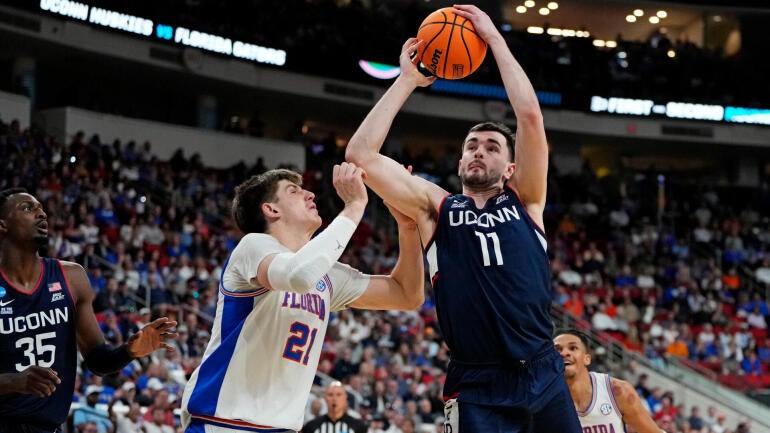
The return of the AP Top 25 is a kind reminder that basketball season is here. Clearly, the top objective for college basketball scribes throughout the country is to outperform the football projections that look awfully dire past the midway point of the season.
On paper, the initial AP Top 25 is tame. There were not any egregious additions or omissions.
Let's dive into the projected starting lineups and the biggest strengths and weaknesses for each club.
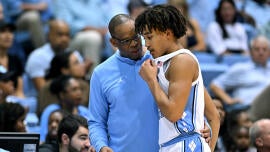

1. Purdue
Projected starting lineup
Top reserves: C Daniel Jacobsen, G Omer Mayer, G Gicarri Harris, F Liam Murphy, G Antione West Jr.
Biggest strengths: Purdue's personnel is different. Smith is the best point guard in America, and Kaufman-Renn is a problem in the paint. A Smith pocket pass to Kaufman-Renn was one of the most unguardable actions in the sport. Smith fed Kaufman-Renn for a whopping 236 points last year, per CBB Analytics, and it should be a go-to feature of a Purdue offense that could be the best in America in 2025-26. Purdue always has loads of shooting, and this year is no different with Loyer, Cox, Mayer, Murphy and Harris. A fresh bill of health for 7-foot-4 center Jacobsen and the addition of South Dakota State transfer Cluff should buff up the Boilermakers' interior defense and rebounding, which were two major stumbling blocks a year ago.
Potential weaknesses: This roster is not abounding with tip-top athleticism, and that could be exacerbated by the departures of high-flying wings, namely Myles Colvin (to Wake Forest) and Camden Heide (to Texas). Functionally, it will show up the most on defense. Can Purdue find someone to handle those tough assignments against big wings? Is the combination of Cluff and Kaufman-Renn mobile enough defensively? Can Purdue's defense be disruptive? Or is this just a defense forced to play a barrage of drop coverage and hope to win the shot-quality game?

2. Houston
Projected starting lineup
- G Milos Uzan
- G Emanuel Sharp
- G Isiah Harwell
- F Chris Cenac Jr.
- F Joseph Tugler
Top reserves: G Kingston Flemings, F Kalifa Sakho, G Mercy Miller, G Ramon Walker, G Chase McCarty, F Jacob McFarland
Biggest strengths: Houston's defense should not miss a beat thanks to the return of Uzan (a twitchy point of attack defender), Sharp (a burly, physical wing defender) and Tugler (a menace both at the rim and blitzing ball screens). That's three plus defenders at three levels of the floor. Add in five-star freshman like Harwell plus a program staple in Walker, and Houston has four enormous guards to sic against any opposing backcourt. Oh, and Houston has an influx of NBA talent with Harwell, Cenac and Flemings headlining the program's best recruiting haul of the modern era.
A talent-maximizing coach like Kelvin Sampson, armed with next-level prospects, is a scary proposition for the Kings of the Big 12.
Potential weaknesses: I'm curious how this halfcourt offense coalesces with some young guys thrust into big roles. When Houston needed a bucket, grizzled veterans like LJ Cryer or J'Wan Roberts often earned the call. Houston will miss Roberts' mid-post backdowns and Cryer's dynamic shot-making. Can Cenac replace some of Roberts' isolation brilliance? Harwell is not quite a burner like Cryer, so it'll be up to Sharp and Uzan to expand their offensive roles to new heights.

3. Florida
Projected starting lineup
Top reserves: G CJ Ingram, C Micah Handlogten, G Urban Klavzar, G AJ Brown, G Isaiah Brown
Biggest strengths: Todd Golden may have the best frontcourt in America with Haugh, Condon, Chinyelu and Handlogten in the fold. That fearsome foursome should help Florida dominate the glass, control the paint and kickstart a smashmouth transition attack. It keeps the floor incredibly high for the Gators, even though the brilliant Walter Clayton Jr. is off to the NBA. The Gators should be able to replace Clayton's production in the aggregate. Haugh will earn more burn and is a future NBA player. Condon will get a little better in Year 3. Fland, an Arkansas transfer, is going to be terrific in this guard-friendly scheme, and Florida is prepared to trot out some double-barreled, two-point guard looks with Lee next to Fland. Both are tried-and-true shot creators who posted low turnover rates last year. That's essential for the math to tilt in Florida's favor.
Potential weaknesses: Haugh starting at the 3 should be fine because his handle is so nifty, but Florida still needs a third guard to emerge. Golden has multiple bites at the apple with Ingram, Klavzar and the Brown brothers (AJ and Isaiah), but the Gators won the National Championship because they had multiple secondary guards (Alijah Martin, Denzel Aberdeen and Will Richard) who were huge assets on both ends of the floor. Does this roster have that behind Fland? We're about to find out.

4. UConn
Projected starting lineup
Top reserves: F Jaylin Stewart, G Malachi Smith, F Eric Reibe, G/F Jayden Ross, G Jacob Furphy
Biggest strengths: A scheme like this with shooters of UConn's ilk is utopia. The threat of the 3-ball from Demary, Ball, Mullins and Karaban (who could all shoot over 37% from downtown on high volume) should fuel a top-five offense, especially paired with Reed, who is a beast in the paint. Dan Hurley can go big or small at a moment's notice, and that optionality is everything in the chase for a championship.
UConn's point guard play was dire for long stretches last year, but portal imports like Demary and Smith should transform it from a weakness to a strength. Purdue enters 2025-26 as the favorite to be the No. 1 offense in the country, but UConn is one of the few that could realistically vault the Boilermakers.
Potential weaknesses: It's all about the defense if UConn wants to achieve its lofty goals. Can Reed protect the rim and anchor this defense without fouling every other possession? Can Ball improve as a point of attack defender? What are UConn's counters if it can't protect the rim when Reed isn't on the floor?

5. St. John's
Projected starting lineup
Top reserves: F Dillon Mitchell, G Dylan Darling, F Ruben Prey, G Kelvin Odih
Biggest strengths: The relentless energy and physicality from the Hopkins-Ejiofor frontcourt pairing makes St. John's enticing. Those two forwards are big, strong and nasty. St. John's can also throw Mitchell into the fray, and he's one of the elite athletes in all of college basketball. St. John's isn't just athletic and strong, it's also got real-deal speed. Hopkins and Ejiofor are glass-cleaners, and that should allow the jet-quick Jackson to just obliterate defenders in transition.
The top-four guards (Jackson, Sellers, Sanon and Darling) all shot over 35% on more than 4.0 attempts per game last season, and you know St. John's is going to be an excellent offensive rebounding team. That's a splendid combination for this offense to take a major step in the right direction, especially after last year when St. John's rated outside the top-200 nationally in offensive efficiency in the halfcourt, per Synergy.
Potential weaknesses: For all the consternation about St. John's point guard play (it'll be fine), it's really the other end that matters way more to me. Rick Pitino has his work cut out for him to mold this new-look group into the desperate group of defensive hyenas that willed the 2024-25 Johnnies to a Big East championship. RJ Luis, Deivon Smith, Aaron Scott and Kadary Richmond were excellent individual defenders. Jackson and Sanon, specifically, both struggled on defense last year. St. John's has two impeccable interior defenders in Mitchell and Ejiofor, but they're going to be asked to douse a ton of fires if the point of attack defense slips.
If Pitino builds another top-five defense out of this personnel, just give him National Coach of the Year right now.

6. Duke
Projected starting lineup
- G Caleb Foster
- G Isaiah Evans
- G/F Dame Sarr
- F Cameron Boozer
- F Patrick Ngongba II
Top reserves: G Cayden Boozer, F Maliq Brown, F Nikolas Khamenia, G Darren Harris, F Sebastian Wilkins
Biggest strengths: Jon Scheyer has a little bit of everything in this frontcourt. Cameron Boozer is a future top-three pick, Ngongba is a serious candidate for a sophomore surge and Brown is one of the special defensive forwards in the sport. Duke's offense has so many buttons it can press because all three of its bigs have proven they can decipher defenses at a high level.
Potential weaknesses: Duke has built one of the biggest rosters with no one shorter than 6-5 in the rotation, but there are still defensive questions. Duke was good, not great, at protecting the rim whenever Khaman Maluach was off the floor. Without Maluach and Cooper Flagg, can this team be an elite shot-blocking team? Also, Duke's go-to closing lineup last year had no bad defenders. Can Evans level up to make sure that Duke's weak link isn't a hot spot?

7. Michigan
Projected starting lineup
Top reserves: F Morez Johnson Jr., G Trey McKenney, F Will Tschetter, G LJ Cason, G Winters Grady
Biggest strengths: Michigan has everything it needs to build a dominant defense. Mara and Johnson provide 40 minutes of rim protection. Lendeborg is a Swiss Army Knife defensively. Burnett and Gayle are big, strong, veteran guards who bring it defensively. Cadeau can be an unscreenable pest when he wants to be. Michigan's struggles to defensive rebound were well-documented last year and a huge point of emphasis for Dusty May's staff. If this group struggles to rebound, May will pop a gasket. There's no excuse for Michigan not to be one of the best rebounding teams in the country.
Potential weaknesses: There were a ton of notable struggling offenses last year that shared a similar roster-construction blueprint. Mixing a low-volume shooter at point guard with a non-shooting center created too many issues. May has to work around that with Cadeau and the Johnson/Mara platoon this year. There's enough pathways for Michigan to avoid too many hiccups (like transition, offensive rebounding and a sharp scheme), but the historical trends aren't pretty.

8. BYU
Projected starting lineup
- G Rob Wright
- G Kennard Davis
- G Richie Saunders
- G/F AJ Dybantsa
- F Keba Keita
Top reserves: G Dawson Baker, F Dominique Diomande, F Mihailo Boskovic, F Xavion Staton, F Tyler Mrus
Biggest strengths: BYU's offense can press so many different buttons. The pick-and-roll game with Wright should be electric. Richie Saunders' off-ball cutting makes him a hard cover. Dybantsa's barrage of free throws and transition adds a new layer. There's spot-up options galore to drill 3-pointers. Kevin Young's offensive personnel is so much more athletic this year.
Potential weaknesses: Top-100 teams averaged 116.0 points per 100 possessions against BYU when Keita was not on the floor. BYU has to find defensive answers when the big fella needs a blow or gets in foul trouble.

9. Kentucky
Projected starting lineup
- G Jaland Lowe
- G Otega Oweh
- G Denzel Aberdeen
- F Mo Dioubate
- F Brandon Garrison
Top reserves: C Jayden Quaintance (if healthy), G Jasper Johnson, F Kam Williams, G Collin Chandler, F Malachi Moreno
Biggest strengths: Kentucky has way more options to go create a bucket out of nothing. Mark Pope's system should weaponize dribble-drive slashers like Lowe, Oweh, Aberdeen and Dioubate. Once the ball gets popping, Kentucky can be a brutal team to defend with this level of athlete in a system this intricate.
Potential weaknesses: Can Pope find a big man who can make reads? Garrison is the adult in the room, but his decision-making left a lot to be desired last year. Freshman big man Moreno has impressed and could garner more minutes if he can decipher defenses quickly. How much has Quaintance been able to pick up in the film room while being sidelined with a knee injury? That's the biggest concern for this offense right now.

10. Texas Tech
Projected starting lineup
Top reserves: G Donovan Atwell, F Josiah Moseley, G Jaylen Petty
Biggest strengths: Texas Tech's offensive pieces fit nearly flawlessly together. Toppin is the fulcrum, and the pick-and-roll game with Anderson should hum with snipers like Bryan or Atwell spacing the floor. Watts is slated to adopt the Darrion Williams role as a bootyball threat who can create advantages in backdowns. Texas Tech can even get some vertical spacing with Bamgboye or some instant offense from freshman guard Petty. Elijah Hawkins' pocket passes will be missed, but Texas Tech is an exceptionally built team with a chance to hum offensively.
Potential weaknesses: Who is the defensive stopper on the perimeter? Texas Tech's best defense may be an offense that forces you to take it out of the net repeatedly, but someone needs to become that go-to plus defender who can turn the water off. Watts' defensive chops are underrated, so maybe he becomes that guy, but none of these Texas Tech guards have established themselves as lockdown defenders yet.

11. Louisville
Projected starting lineup
Top reserves: G Adrian Wooley, F Kasean Pryor, C Aly Khalifa, F Khani Rooths, F Vangelis Zougris, G Kobe Rodgers
Biggest strengths: Shooting, shooting, shooting. Very few teams can offset the snipers Louisville has at its disposal. Conwell was one of the best five shooters in the Big East. McKneely was one of the best five shooters in the ACC. Brown Jr. is one of the top shooters in the freshman class. They're all on the same team. Pat Kelsey could have multiple guys crack 100 3-pointers next year, which is outrageous.
Potential weaknesses: Louisville's interior defense does not project to be a real strength when Fru is not on the floor. There's a real chance it's a layup line for Louisville opponents when Khalifa is on the floor at the 5-spot.

12. UCLA
Projected starting lineup
Top reserves: G Trent Perry, F Steven Jamerson II, F Brandon Williams
Biggest strengths: UCLA's best four players are so steady. Dent is one of the top floor generals. Clark has become an outstanding two-way guard. Dailey Jr. and Bilodeau provide two more skilled forwards who can score inside and out. When your best four players have this much game, you have a chance at a special year.
Potential weaknesses: Will Michigan State transfer Booker and San Diego transfer Jamerson II fix UCLA's interior defensive issues. In 19 Quad 1 games, opponents shot 72% at the rim against UCLA when big man Aday Mara was not on the floor, per CBB Analytics. That ranked in the second (!) percentile nationally.

13. Arizona
Projected starting lineup
- G Jaden Bradley
- G Brayden Burries
- G Anthony Dell'Orso
- F Koa Peat
- F Tobe Awaka
Top reserves: C Motiejus Krivas, F Ivan Kharchenkov, G/F Dwayne Aristode, C Sidi Gueye, G Evan Nelson
Biggest strengths: Arizona's paint-dominance recipe is not going anywhere with Peat, Awaka and Krivas leading the charge. Arizona will be one of the superior rebounding teams in the country, and it has the athletes to crush opponents in transition.
Potential weaknesses: Arizona was playing its best basketball last year when it had a center on the floor who could hit 3-pointers. On paper, that doesn't seem to be in the cards with Awaka and Krivas splitting time at the 5. What counters does Tommy Lloyd have in his bag?

14. Arkansas
Projected starting lineup
- G DJ Wagner
- G Darius Acuff
- G/F Karter Knox
- F Trevon Brazile
- F Nick Pringle
Top reserves: F Malique Ewin, G/F Billy Richmond III, G Meleek Thomas, G/F Isaiah Sealy
Biggest strengths: Arkansas' raw athleticism jumps off the tape. Knox, Brazile and Richmond are ridiculous athletes who breathe different air than the rest of us. Pringle is so big and strong inside. Acuff and Wagner are twitchy, chiseled lead guards. The Hogs can overwhelm you in a hurry.
Potential weaknesses: Role allocation is something this team has to figure out. Is Acuff the alpha? Is it Knox? Ewin will want his touches. Thomas is wired to score when he checks in. Wagner still has those moments where he wants to go make a play. The collection of talent is obvious, but Arkansas' pecking order is far from settled.

15. Alabama
Projected starting lineup
Top reserves: G Jalil Bethea (when healthy), G Houston Mallette, C Noah Williamson, F London Jemison, G Davion Hannah, F Amari Allen
Biggest strengths: Alabama was 20-3 when it scored at least 15 transition points last year, and the Crimson Tide have the personnel to copy that blueprint again. Both Philon and Holloway can go in the open floor, and Nate Oats will be winding his arm like a third-base coach on the sideline. Don't overlook the addition of Bol Bowen, who can also take it off the glass and push the break.
When Wrightsell and Bethea get back to 100%, Alabama's going to unleash an avalanche of those ultra-valuable transition 3-pointers.
Potential weaknesses: Alabama had a cavalry of switchable frontcourt wings and forwards that you need to survive in the SEC, but Grant Nelson exhausted his eligibility and Mouhamed Dioubate, Derrion Reid and Jarin Stevenson transferred. Oats needs defensive stoppers to emerge on the wing. Bol Bowen will get the first crack, but keep an eye on Jemsion and Allen. Both four-star freshmen have excellent positional size and could use defense to crack this rotation. Alabama needs at least one of them to hit in a big way.

16. Iowa State
Projected starting lineup
- G Tamin Lipsey
- G Jamarion Batemon
- F Milan Momcilovic
- F Joshua Jefferson
- F Blake Buchanan
Top reserves: G Nate Heise, G Dominick Nelson, F Eric Mulder, F Dominykas Pleta, G Killyan Toure, G Cade Kelderman
Biggest strengths: There's comfort in consistency, and Iowa State has it with Lipsey, Momcilovic and Jefferson returning. Lipsey and Jefferson are two of the best defenders in the country at their respective positions, and Momcilovic is a total bucket who knows the defensive scheme like the back of his hand. A mobile big man like Buchanan should be a nifty fit for an Iowa State defense that should be a top-five unit in America.
Potential weaknesses: Does this backcourt have enough on-ball juice? Iowa State is banking on Lipsey staying healthy and returning to his All-American form, but freshman Batemon might need to be a dude right away. Iowa State is so clearly a good team, but it looks one guard short of the top tier of national title contenders. The dynamic transition attacks from Keshon Gilbert and the Curtis Jones heaters will be sorely missed.

17. Illinois
Projected starting lineup
Top reserves: G Mihailo Petrovic, C Zvonimir Ivisic, F David Mirkovic, G Brandon Lee, F Jake Davis, F Ty Rodgers (when healthy)
Biggest strengths: Brad Underwood's offense is about to sizzle. 7-foot center Tomislav Ivisic is the ultimate lid-lifter with his shower of 3-pointers and gorgeous over-the-top dimes. Illinois shot a scalding 70% at the rim when Ivisic was on the floor last year, and the paint will be wide open for physical drivers like Boswell and Stojakovic to eat. Illinois' transition offense should bounce back in a major way with speedy guards like Petrovic and Boswell pushing the pace, and keep an eye on freshman Keaton Wagler, who has impressed with his shot-making, poise and feel. I have Illinois rated as the sixth-best offense in the country (KenPom echoed that projection a few months later!). That may end up being too low for the Balkan Boys. This offense has so many outs to create good looks.
Potential weaknesses: Illinois has a ton of size up front, and Boswell is one of the best five point of attack defenders in the country. But this is not the most athletic roster, and the Illini have been a bit snakebitten with minor injuries in the preseason to their top dawgs. Tomislav Ivisic (tonsillectomy), Stojakovic (knee sprain) and Petrovic (eligibility red tape) have all missed chunks of time, and that doesn't even factor in Rodgers' serious knee injury. Illinois is trying to implement a new defensive scheme under new assistant Camryn Crocker without major pieces on the floor. There could be some growing pains because the defensive chemistry has not been established yet.

18. Tennessee
Projected starting lineup
Top reserves: F Jaylen Carey, F JP Estrella, G Ethan Burg, G Bishop Boswell, F DeWayne Brown, G/F Amari Evans
Biggest strengths: Tennessee has some ludicrous defensive lineups that it can trot out. Gillespie is a solid defender, Ament has excellent defensive tools, Phillips is an outstanding interior defender that no one knows about yet and Okpara is one of the best shot-blockers in the SEC. Even without Zakai Zeigler and Jahmai Mashack, Tennessee's defense will be vicious. Good luck scoring in. the paint against that front-line trio of Ament, Phillips and Zeigler.
Potential weaknesses: There will be a heavy load on Gillespie and Ament to run the show offensively. Can a third guy emerge? Keep an eye on Estrella, who might be Tennessee's most talented offensive big man. He just missed a huge chunk of last year with a foot injury and he's already missed time this preseason with a nasty ankle sprain. If he can get on the floor, Estrella's soft touch in the paint can help this Vols' offense immensely.

19. Kansas
Projected starting lineup
Top reserves: G Elmarko Jackson, F Bryson Tiller, C Paul Mbiya, G Kohl Rosario, G Jamari McDowell
Biggest strengths: Kansas desperately needed more pep from the lead guard spot. Insert Peterson, who could very well cement himself as the best player in the Big 12, a First Team All-American and the unquestioned No. 1 pick in the NBA Draft. Kansas' playbook can expand with Peterson at the helm, and his flurry of stutter-step drives, in-your-eyehole treys and unselfish playmaking will give Bill Self the engine it needs to go. Peterson is going to post ludicrous counting stats in 2025-26.
Oh, and Kansas can pair a future lottery pick with the bones of an impressive defense that can grind teams into a pulp. It has big, physical guards. It has a terrifying rim protector in Bidunga, and the threat of a double-big lineup if Self chooses to toss Mbiya into the fray. Even without any continuity, Kansas can be one of the Big 12's best defenses.
Potential weaknesses: This may be one of the most unproven bench groups that Self has ever had. Kansas doesn't have that second-unit dude who can change the game in a flash. Can Jackson get healthy after missing all of last year? Is Tiller ready to be a piece and live up to the early recruiting hype? Can Rosario, a reclassified freshman from OTE, settle in as a 3-and-D role player? Can Mbiya play next to Bidunga or is he strictly going to be a backup 5-man? Kansas has lots of roles to figure out in the preseason.

20. Auburn
Projected starting lineup
Top reserves: F Filip Jovic, G Kaden Magwood, C Emeka Opurum, G Abdul Bashir, F Sebastian Williams-Adams
Biggest strengths: Auburn may very well be the best isolation scoring team in America. Pettiford, Hall, Murphy and Magwood can all create something for themselves in a jiffy. Auburn should be able to build its entire offense off the bucket-getting brilliance.
Potential weaknesses: The Tigers' rim protection seems destined to take a significant step back without Johni Broome and Dylan Cardwell patrolling the paint. I'm curious how it changes the structure of this defense, and how long it takes for this new-look team to find consistency and synergy on that end.

21. Gonzaga
Projected starting lineup
- G Braeden Smith
- G Adam Miller
- G/F Tyon Grant-Foster (if eligible)
- F Braden Huff
- F Graham Ike
Top reserves: G Mario Saint-Supery, G Emmanuel Innocenti, F Steele Venters, C Ismaila Diagne, G/F Jalen Warley, G/F Davis Fogle
Biggest strengths: Gonzaga is on the verge of unleashing a dangerous double-big lineup of Ike and Huff, and the ripple effects are obvious. Gonzaga's transition ethos isn't going anywhere. It will get you in the bonus. It will generate a paint touch and play off it. The Zags shot 69% at the rim last season -- which ranked in the 96th percentile nationally -- and the Ike-Huff duo should keep the train rolling.
The frontcourt is going to carry this team.
Potential weaknesses: Gonzaga has so much depth on the wing, but can some two-way players emerge outside of Adam Miller and Grant-Foster (if cleared). Innocenti is a whale of a defender, but the offense leaves room to be desired. Venters can make jumpers, but how's the lateral movement defensively after two years of leg injuries? Can Warley (a non-shooter) play with Ike and Huff? Some tinkering seems imminent for this sharp Gonzaga coaching staff to figure out the right combinations to fully weaponize this deep club.

22. Michigan State
Projected starting lineup
Top reserves: G Kur Teng, F Cam Ward, G Divine Ugochukwu, F Jesse McCulloch, G/F Jordan Scott
Biggest strengths: Michigan State should smother teams defensively. Fears has clamps, Carr is the most athletic player in the country and both Kohler and Cooper are immovable, stout interior defenders. That quartet also demands defensive buy-in from the rest of the roster, while covering up some of their warts. Michigan State could certainly have the top defensive unit in the Big Ten.
Potential weaknesses: Fears, Carr, Kohler and Cooper all need to add more to their offensive portfolios for MSU to be allowed to play its best defensive lineup. Offseason buzz is what it is. We'll start to see if the offensive gains are real when Michigan State hosts Bowling Green for an exhibition in less than 10 days. That Oct. 28 exhibition against UConn will be illuminating, too.

23. Creighton
Projected starting lineup
- G Nik Graves
- G Josh Dix
- G/F Blake Harper
- F Jackson McAndrew
- F Owen Freeman
Top reserves: G Fedor Zugic, G Austin Swartz, F Jasen Green, F Isaac Traudt, G Hudson Greer, G Ty Davis
Biggest strengths: It's almost a felony to play for Creighton and not be able to drain 3-pointers. Creighton's barrage of snipers will come at you in waves. Every single guy in this rotation can make a jumper if you leave him open. Very few teams can say that. Dix, McAndrew and Freeman are the top dawgs, though. Dix is one of the most efficient three-level scorers in America, and McAndrew can heat up from well beyond NBA range in a New York second. All that space should help Freeman pour in buckets in the paint at will. Creighton's offense has such a high floor under Greg McDermott.
Potential weaknesses: There are loads of defensive questions littered up and down the roster. Is Dix the best perimeter defender on this team? If so, that's probably not an ideal sign. Can Freeman get healthy and execute Creighton's drop coverage-happy scheme?

24. Wisconsin
Projected starting lineup
Top reserves: G Braeden Carrington, G Jack Janicki, C Will Garlock, F Elijah Gray, G Hayden Jones, C Aleksas Bieliauskas, G Zach Kinziger
Biggest strengths: Even without prized offensive coordinator Kirk Penney, Wisconsin still has the personnel to turbo-smash offensively. Boyd, Blackwell and Rohde are three guards who can make reads in ball screens or operate as off-ball snipers. Wisconsin's frontcourt duo of Rapp and Winter will have the freedom to go "bombs away" from downtown. The Badgers could certainly get more treys from their frontcourt than almost any other high-major team.
Potential weaknesses: There is a ton on Winter's plate to anchor this defense effectively. He's packed on weight to his 7-foot frame, and his combination of length, athleticism and shot-blocking potential is intriguing. If he's a game-changer defensively, Wisconsin's ceiling is very high. But that's a big if.

25. North Carolina
Projected starting lineup
Top reserves: F Jarin Stevenson, G Derek Dixon, G Jonathan Powell, G Jaydon Young, F Zayden High, F James Brown, G Isaiah Denis
Biggest strengths: UNC has a nasty point of attack defender in Trimble, an excellent hybrid wing/forward defender in Wilson and a mobile shot-blocker inside with Veesaar. UNC has buffed up its athleticism in a serious way. If this defense is not much improved, something seriously went wrong.
Potential weaknesses: This roster is jam-packed with combo guards. Evans, Dixon, Trimble, Bogavac and Young can all play with the ball in their hands, but there's no true initiator point guard on the roster. Who emerges as the organizer and sets the table effectively?


